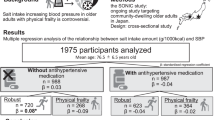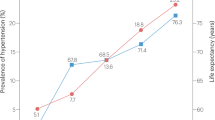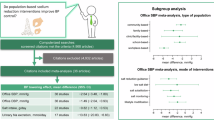Abstract
There is a paucity of high-quality evidence on the effectiveness and safety of salt reduction strategies, particularly for older people, who have the most to benefit but are at higher risk of adverse effects. Here, we conducted a clinical trial in which 48 residential elderly care facilities in China (1,612 participants including 1,230 men and 382 women, 55 years or older) were cluster-randomized using a 2 × 2 factorial design to provision of salt substitute (62.5% NaCl and 25% KCl) versus usual salt and to a progressively restricted versus usual supply of salt or salt substitute for 2 years. Salt substitute compared with usual salt lowered systolic blood pressure (–7.1 mmHg, 95% confidence interval (CI) –10.5 to –3.8), meeting the primary outcome of the trial, whereas restricted supply compared with usual supply of salt or salt substitute had no effect on systolic blood pressure. Salt substitute also lowered diastolic blood pressure (–1.9 mmHg, 95% CI –3.6 to –0.2) and resulted in fewer cardiovascular events (hazard ratio (HR) 0.60, 95% CI 0.38–0.96), but had no effect on total mortality (HR 0.84, 95% CI 0.63–1.13). From a safety standpoint, salt substitute increased mean serum potassium and led to more frequent biochemical hyperkalemia, but was not associated with adverse clinical outcomes. In contrast, salt restriction had no effect on any study outcome. The results of this trial indicate that use of salt substitute, but not efforts to restrict salt supply, may achieve blood pressure lowering and deliver health benefits to residents of elderly care facilities in China. Clinicaltrials.gov registration: NCT03290716
This is a preview of subscription content, access via your institution
Access options
Access Nature and 54 other Nature Portfolio journals
Get Nature+, our best-value online-access subscription
$32.99 / 30 days
cancel any time
Subscribe to this journal
Receive 12 print issues and online access
$259.00 per year
only $21.58 per issue
Buy this article
- Purchase on SpringerLink
- Instant access to full article PDF
Prices may be subject to local taxes which are calculated during checkout



Similar content being viewed by others
Data availability
The availability of anonymized clinical and anthropometric data will be considered based on a proposal review subject to an internal review by the study management committee, completion of a data sharing agreement and in accordance with the Peking University’s Institutional Review Board and institutional guidelines, to ensure that the participants’ anonymity and confidentiality are protected. Please submit requests to Y.W. (wuyf@bjmu.edu.cn) copying H.L. (pucri_lihj@bjmu.edu.cn). Deidentified participant data and a data dictionary will be made available following approval. A detailed research protocol and statistical analysis plan will be shared as the supplements of this publication.
References
GBD 2017 Risk Factor Collaborators, Global, regional, and national comparative risk assessment of 84 behavioural, environmental and occupational, and metabolic risks or clusters of risks for 195 countries and territories, 1990-2017: a systematic analysis for the Global Burden of Disease Study 2017. Lancet 392, 1923–1994 (2018).
He, F. J., Li, J. & Macgregor, G. A. Effect of longer term modest salt reduction on blood pressure: Cochrane systematic review and meta-analysis of randomised trials. Br. Med. J. 346, f1325 (2013).
Filippini, T., Violi, F., D’Amico, R. & Vinceti, M. The effect of potassium supplementation on blood pressure in hypertensive subjects: a systematic review and meta-analysis. Int. J. Cardiol. 230, 127–135 (2017).
Powles, J. et al. Global, regional and national sodium intakes in 1990 and 2010: a systematic analysis of 24 h urinary sodium excretion and dietary surveys worldwide. BMJ Open 3, e003733 (2013).
Jin, A., Xie, W. & Wu, Y. Effect of salt reduction interventions in lowering blood pressure in Chinese populations: a systematic review and meta-analysis of randomised controlled trials. BMJ Open 10, e032941 (2020).
Hernandez, A. V. et al. Effect of low-sodium salt substitutes on blood pressure, detected hypertension, stroke and mortality. Heart 105, 953–960 (2019).
O’Donnell, M. J. et al. Urinary sodium and potassium excretion and risk of cardiovascular events. JAMA 306, 2229–2238 (2011).
Dent, A., Walmsley, D. & Dhandapani, S. Hyperkalaemia is a risk with low sodium salt in vulnerable patients. Br. Med. J. 343, d4514 (2011).
Ayach, T., Nappo, R. W., Paugh-Miller, J. L. & Ross, E. A. Life-threatening hyperkalemia in a patient with normal renal function. Clin. Kidney J. 7, 49–52 (2014).
Greer, R. C. et al. Potassium-enriched salt substitutes as a means to lower blood pressure: benefits and risks. Hypertension 75, 266–274 (2020).
Marklund, M. et al. Estimated population wide benefits and risks in China of lowering sodium through potassium enriched salt substitution: modelling study. Br. Med. J. 369, m824 (2020).
Chang, H. Y. et al. Effect of potassium-enriched salt on cardiovascular mortality and medical expenses of elderly men. Am. J. Clin. Nutr. 83, 1289–1296 (2006).
Neal, B. et al. Effect of salt substitution on cardiovascular events and death. N. Engl. J. Med. 385, 1067–1077 (2021).
Losby, J. L. et al. Sodium-reduction strategies for meals prepared for older adults. J. Public Health Manag. Pract. 20, S23–S30 (2014).
Rodgers, A. & Neal, B. Less salt does not necessarily mean less taste. Lancet 353, 1332 (1999).
Girgis, S. et al. A one-quarter reduction in the salt content of bread can be made without detection. Eur. J. Clin. Nutr. 57, 616–620 (2003).
Jin, A. et al. Impact of salt substitute and stepwise reduction of salt supply on blood pressure in residents in senior residential facilities: design and rationale of the DECIDE-Salt trial. Am. Heart J. 226, 198–205 (2020).
Institute of Medicine. Sodium Intake in Populations: Assessment of Evidence (eds. Strom, B.L., Yaktine, A.L. & Oria, M.) 1–10 (The National Academies Press, 2013).
Peng, Y. G. et al. Effects of salt substitutes on blood pressure: a meta-analysis of randomized controlled trials. Am. J. Clin. Nutr. 100, 1448–1454 (2014).
Ettehad, D. et al. Blood pressure lowering for prevention of cardiovascular disease and death: a systematic review and meta-analysis. Lancet 387, 957–967 (2016).
Eriksen, B. O. et al. GFR in healthy aging: an individual participant data meta-analysis of iohexol clearance in European population-based cohorts. J. Am. Soc. Nephrology 31, 1602–1615 (2020).
Liu, P. et al. Accounting for age in the definition of chronic kidney disease. JAMA Intern. Med. 181, 1359–1366 (2021).
Jin, A. et al. Normal range of serum potassium, prevalence of dyskalaemia and associated factors in Chinese older adults: a cross-sectional study. BMJ Open 10, e039472 (2020).
He, F. J., Markandu, N. D., Sagnella, G. A., de Wardener, H. E. & MacGregor, G. A. Plasma sodium: ignored and underestimated. Hypertension 45, 98–102 (2005).
Bolhuis, D. P. et al. A salt reduction of 50% in bread does not decrease bread consumption or increase sodium intake by the choice of sandwich fillings. J. Nutr. 141, 2249–2255 (2011).
McGuire, S. Institute of Medicine. 2010. Strategies to reduce sodium intake in the United States. Washington, DC: The National Academies Press. Adv. Nutr. 1, 49–50 (2010).
Manson, J. E. et al. Marine n-3 fatty acids and prevention of cardiovascular disease and cancer. N. Engl. J. Med. 380, 23–32 (2019).
Manson, J. E. et al. Vitamin D supplements and prevention of cancer and cardiovascular disease. N. Engl. J. Med. 380, 33–44 (2019).
McAlister FA, S. S., Sackett, D. L. & Altman, D. G. Analysis and reporting of factorial trials: a systematic review. JAMA 289, 2545–2553 (2003).
Bernabe-Ortiz, A. et al. Effect of salt substitution on community-wide blood pressure and hypertension incidence. Nat. Med. 26, 374–378 (2020).
Yu, J. et al. Effects of a reduced-sodium added-potassium salt substitute on blood pressure in rural Indian hypertensive patients: a randomized, double-blind, controlled trial. Am. J. Clin. Nutr. 114, 185–193 (2021).
Geleijnse, J. M., Witteman, J. C., Bak, A. A., den Breeijen, J. H. & Grobbee, D. E. Reduction in blood pressure with a low sodium, high potassium, high magnesium salt in older subjects with mild to moderate hypertension. BMJ 309, 436–440 (1994).
Muntner, P. et al. Measurement of blood pressure in humans: a scientific statement from the American Heart Association. Hypertension 73, e35–e66 (2019).
Rabin, R. & de Charro, F. EQ-5D: a measure of health status from the EuroQol Group. Ann. Med. 33, 337–343 (2001).
Nikolac Gabaj, N. et al. Precision, accuracy, cross reactivity and comparability of serum indices measurement on Abbott Architect c8000, Beckman Coulter AU5800 and Roche Cobas 6000 c501 clinical chemistry analyzers. Clin. Chem. Lab. Med. 56, 776–788 (2018).
Carobene, A., Ceriotti, F., Infusino, I., Frusciante, E. & Panteghini, M. Evaluation of the impact of standardization process on the quality of serum creatinine determination in Italian laboratories. Clin. Chim. Acta 427, 100–106 (2014).
Cnaan, A., Laird, N. M. & Slasor, P. Using the general linear mixed model to analyse unbalanced repeated measures and longitudinal data. Stat. Med. 16, 2349–2380 (1997).
Hougaard, P. Frailty models for survival data. Lifetime Data Anal. 1, 255–273 (1995).
Goel, M. K., Khanna, P. & Kishore, J. Understanding survival analysis: Kaplan–Meier estimate. Int. J. Ayurveda Res. 1, 274–278 (2010).
Tango, T. On the repeated measures designs and sample sizes for randomized controlled trials. Biostatistics 17, 334–349 (2016).
Acknowledgements
The authors thank all facility residents for their participation and cooperation. We also like to thank all investigators, study team members, facility managers and staff, and administrative agencies for their proactive participation in the study. We are also grateful to K. Liu at the Northwestern University School of Medicine for his advice on study design and statistical analysis plan development. The trial was supported by the National Key Research and Development Program, Ministry of Science and Technology of China, through the research grant ‘Diet, ExerCIse and CarDiovascular hEalth (DECIDE) project’ (2016YFC1300200). China Salt General Company at Yulin provided the usual salt and salt substitute used in the study free of charge. The funders of the study had no role in the study design, data collection, data analysis, data interpretation or writing of the report.
Author information
Authors and Affiliations
Contributions
Y.W. and A.J. designed the study with advice from D.L. and B.N. The Statistical Analysis Plan was finalized by Y.W., P.G. and Y.Y. before closing of the database. Y.Y. and A.J. analyzed and verified the data analysis. P.G., D.L. and P.E. helped on data analysis and interpretation. Y.Y., A.J., B.N. and Y.W. wrote the first draft with all coauthors participating in the subsequent reviews and revisions. Y.W. had full access to all of the data in the study and takes responsibility for the integrity of the data and the accuracy of the data analysis.
Corresponding author
Ethics declarations
Competing interests
B.N. is supported by a National Health and Medical Research Council Investigator Grant (APP1197709). P.E. is director of the UK Medical Research Council (MRC) Centre for Environment and Health (MR/L01341X/1; MR/S019669/1) and acknowledges support from the National Institute for Health Research (NIHR) Imperial Biomedical Research Centre, the Imperial College British Heart Foundation Centre for Research Excellence (RE/18/4/34215) and the UK Dementia Research Institute at Imperial College London (MC_PC_17114).
Peer review
Peer review information
Nature Medicine thanks Victor Volovici, Simon Capewell and the other, anonymous, reviewer(s) for their contribution to the peer review of this work. Primary Handling Editor: Michael Basson, in collaboration with the Nature Medicine team.
Additional information
Publisher’s note Springer Nature remains neutral with regard to jurisdictional claims in published maps and institutional affiliations.
Extended data
Extended Data Fig. 1 Effects on overall follow-up systolic blood pressure of salt substitute versus usual salt in participant subgroups.
Mean difference and its 95%CI of the effect on overall follow-up systolic blood pressure of salt substitute versus usual salt in participant subgroups was obtained by linear mixed model, accounting for the clustering effect and adjusting for the baseline value. The p value was two-sided and was not adjusted for multiple comparison.
Extended Data Fig. 2 Effects on overall follow-up systolic blood pressure of restricted supply versus usual supply in participant subgroups.
Mean difference and its 95%CI of the effect on overall follow-up systolic blood pressure of restricted supply versus usual supply in participant subgroups was obtained by linear mixed model, accounting for the clustering effect and adjusting for the baseline value. The p value was two-sided and was not adjusted for multiple comparison.
Extended Data Fig. 3 Impact on hyperkalaemia of salt substitute versus usual salt in participant subgroups by selected baseline characteristics.
The error bar is the risk ratio(RR) and its 95% confidence interval of hyperkalemia for salt substitute versus usual salt in each subgroup, obtained by generalized linear mixed models with adjustment for clustering. The p value was two-sided and was not adjusted for multiple comparison. Health conditions included any of the following: hypertension, diabetes mellitus, coronary heart disease, stroke, chronic kidney disease, cancer, chronic obstructive pulmonary disease or being bedridden. Risk of hyperkalemia was defined high if the participant met any of the following at baseline: serum potassium > 5.5 mmol/l, using any medication that may elevate potassium (ACEI/ARBs, potassium-sparing diuretics, beta-blockers), with history of renal disease and eGFR < 60 ml/min*1.73 m3.
Supplementary information
Supplementary Information
Supplementary Tables 1–7.
Supplementary Data
Study protocols and amendments, statistical analysis plan and amendments and original materials in Chinese.
Supplementary Note
Research group information.
Rights and permissions
Springer Nature or its licensor (e.g. a society or other partner) holds exclusive rights to this article under a publishing agreement with the author(s) or other rightsholder(s); author self-archiving of the accepted manuscript version of this article is solely governed by the terms of such publishing agreement and applicable law.
About this article
Cite this article
Yuan, Y., Jin, A., Neal, B. et al. Salt substitution and salt-supply restriction for lowering blood pressure in elderly care facilities: a cluster-randomized trial. Nat Med 29, 973–981 (2023). https://doi.org/10.1038/s41591-023-02286-8
Received:
Accepted:
Published:
Issue date:
DOI: https://doi.org/10.1038/s41591-023-02286-8
This article is cited by
-
Effect of population-based sodium reduction interventions on blood pressure: a systematic review and meta-analysis of randomized trials
Hypertension Research (2025)
-
Hypertension research 2024 update and perspectives: blood pressure management
Hypertension Research (2025)
-
Role of dietary potassium and salt substitution in the prevention and management of hypertension
Hypertension Research (2025)
-
Kalium - eine unterschätzte Option?
CardioVasc (2025)
-
Effects of salt substitution on cumulative blood pressure: a secondary analysis of the SSaSS
European Journal of Epidemiology (2025)



